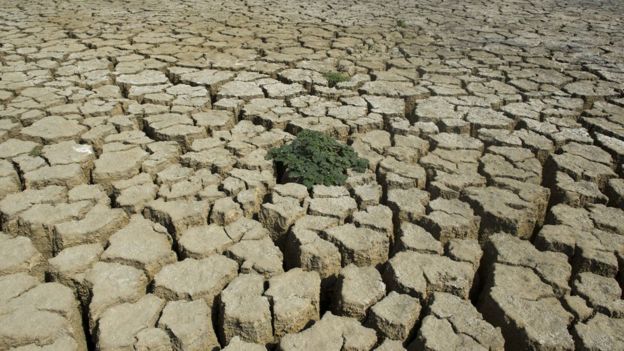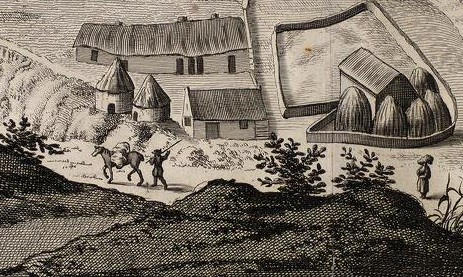By Rolf Schuttenhelm, Bits of Science, October 29, 2017
When you’re looking at the effects of climate change on the forests of Africa, you may be inclined to overlook Madagascar, the continent’s largest island. But especially when biodiversity is your concern, it deserves special attention.
In fact, Madagascar has more endemic-only tree species than any other African country. And although the Congo Basin – Africa’s tropical rainforest heartland – is rich in iconic primates like the chimpanzee, bonobo, and gorilla, Madagascar is the single home of a uniquely separate clade of primates called ‘lemurs’, which evolved independently from monkeys and apes.
Now deforestation, followed by habitat deterioration, are a major threat to different lemur species – with climate change taking aim at the largest of the ‘bamboo lemurs’, a new study warns Madagascar’s greater bamboo lemur – of which only about 500 individuals remain.
Under forces of tectonic rifting Madagascar separated from the African mainland in the Jurassic Period, about 110 million years ago – starting a separate evolutionary path for much of Biology.
Madagascar lies much further to the South than the Congo Basin, Africa’s only large remaining tropical rainforest, and therefore only receives seasonal monsoon rains, while the southern part of the island is actually subtropical. But although similar latitudes in southern Africa are really arid (including the Kalahari desert of Botswana), it’s position in the Indian Ocean adds sufficient extra moisture supply to give the island a lush vegetation, especially along it’s eastern coast, where a special type of rainforest grows – the ‘Madagascar humid forests’.
These East-Madagascan lowland rainforests are a biodiversity hotspot of global significance, included in WWF’s Global 200 ‘list of outstanding ecoregions’– with very unique biodiversity, both in flora and fauna.
A bit inland of these coastal rainforests, tall bamboo species dominate the vegetation, giving rise to actual bamboo forest – bamboo that despite being difficult to digest, low in nutrients, and containing dangerous amounts of cyanide, became the single food source for bamboo lemurs.
Five bamboo lemurs species remain today, several of which are critically endangered. One other similar species, the greater bamboo lemur, is now considered to belong to yet another genus, called Prolemur – of which it is the only living example.
This primate species, also known as the broad-nosed bamboo lemur or the broad-nosed gentle lemur, is the heaviest almost-exclusive bamboo feeder of Madagascar, at about 2.5-kilogram weight. It primarily eats the tall bamboo species Cathariostachys madagascariensis, in which it can jump from stem to stem.
What’s special about this bamboo lemur is that it doesn’t just taste bamboo, it actually eats it – whole. And that’s a rare trait, for any mammal. Or as ecologists from an international research group led by the University of Helsinki phrase it:
“Only two mammals, the giant panda (Ailuropoda melanoleuca) in Asia and the greater bamboo lemur (Prolemur simus) in Madagascar, consume the nutritionally poor and mechanically challenging culm or trunk of woody bamboos.”
These researchers just published a study in Current Biology that focuses on the greater bamboo lemur, its food preferences and also its outlook in a shrinking habitat under a changing climate:
Although paleontological evidence shows that historically this lemur species was widespread across Madagascar; IUCN’s Red List states that today there are just 500 greater bamboo lemurs left, scattered over 11 subpopulations in an elongated and rapidly thinning stretch of bamboo forest in eastern Madagascar – calling it one of the world’s 25 most critically endangered primate species.
Now like other remaining forests south of the African equator, also the bamboo forests of Madagascar will face prolonged droughts under the influence of global climate change. And for this diminishing population of highly specialised primates that might be too much to swallow.
The authors of the new study call bamboo lemurs Madagascar’s ecological equivalent of the giant panda, as it also feeds exclusively on bamboo. And bamboo, they add, is an acquired taste – as it costs almost as much energy to chew and digest as eventually, it gives back when its carbohydrates are oxidized.
This is a balancing act that Madagascar’s greater bamboo lemurs, just like China’s giant panda, evolved to master – but it’s a balance that may flip over, once the quality of the bamboo deteriorates as a result of a lengthening dry season. More specifically the availability of the more nutritious sprouts would be limited to a smaller seasonal time frame, forcing the lemurs to survive on the low-caloric bamboo stems for longer times.
“The results show that culm feeding is restricted to the months of August to November. Shoot feeding begins abruptly with the full onset of the rainy season, and shoots are the primary diet when rainfall exceeds 250 mm/month. The distinct pattern of feeding either on shoots or culm was reported for the same locality 10 years previously, suggesting robust feeding patterns.”
The authors then link to the lemur’s Asian ecological equivalent, referring to described nutritional challenges for the giant panda:
“In China, compounded with human-caused deforestation, changing climate has been suggested to affect bamboo distribution in the 21st century, thereby causing food shortage for the giant panda. Our data suggest that rapidly changing climate may also endanger bamboo feeders in a subtle way by affecting the seasonal availability of preferred bamboo parts, and the giant panda may be similarly vulnerable. Southwestern Madagascar is devoid of P. simus fossil localities, and it also has the longest and the shortest projected durations of dry-season and wet-season feeding, respectively.”
When net energy expenditure rises nutritional balance becomes a matter of life or death, the authors warn, again pointing to the panda – using tooth wear as an indicator of extinction risk:
“Overall, the projected lengthening of the dry-season feeding period would cause prolonged usage of bamboo culm and other mechanically demanding and drier plants, which in addition to nutritional challenges can be predicted to increase the rate of tooth wear, leading to loss in dental function and premature dental senescence. In wild giant pandas, which are obligate bamboo specialists, tooth wear is prevalent, and poor dental condition has been found in dead animals.”
Climate change is an overlying ecological stressor, also threatening remote populations:
“In comparison to human-induced habitat loss directly driving populations to extinction, climate change drives prolongation of the dry season. Hence, P. simus populations in both protected and unprotected areas would be affected, suggesting that protecting the existing habitats might not be enough to guarantee the continued existence at the face of ongoing climate change.”
“Increasing dryness of bamboo would most likely threaten all bamboo specialists, despite their physiological adaptations to have low daily energy expenditure and to cope with chemical defenses of bamboo.”
Climate change is rarely a single killer. But when it acts synergistically with other stressors, it can simply push species over the edge. Here’s just one example – one species, one single mechanism. Now try to multiply for all species in all biomes that experience changes in temperature and rainfall, and a cascade of ecological effects, some immediate and some very slow, in all their surrounding ecosystems.
It is really hard to predict such developments. But sometimes a single case can help develop a sense. Direct habitat destruction may be worse – but climate change is definitely a factor in the Holocene-Anthropocene Mass Extinction.








